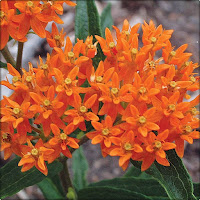Asclepias tuberosa is a perennial plant growing to 0.3–1 metre (1 ft 0 in–3 ft 3 in) tall, with clustered orange or yellow flowers from early summer to early fall. The leaves are spirally arranged, lanceolate, 5–12 cm long, and 2–3 cm broad.This plant favors dry, sand or gravel soil, but has also been reported on stream margins.
It requires full sun.It is commonly known as Butterfly Weed because of the butterflies that are attracted to the plant by its color and its copious production of nectar. It is also the larval food plant of the Queen and Monarch butterflies. Hummingbirds, bees and other insects are also attracted
Origin:
Asclepias tuberosa, the butterfly weed, is a species of milkweed native to eastern North America.
Hardiness:
Hardiness USDA zone 4a to 10b: from −30 °F (−34.4 °C) to 40 °F (+4.4 °C).
How to Grow and Care
You can easily grow Milkweeds to attract the Monarch and other flying creatures to your garden. Plant seeds of the Milkweed Plant indoors or direct sow outside after danger of frost has passed and soil has warmed. If the appearance of the plant is too weedy for your taste, grow Milkweeds in a hidden but sunny corner or at the back of a border.
Milkweed often does not begin growing in northern gardens in time to be fully beneficial to butterflies. There you can start seeds of Milkweed inside so they will be ready to plant when the soil has warmed.
Milkweed plants benefit from vernalization, a process of cold treatment, before sprouting. They get this when planted outside, but to speed up the growing process, treat the seeds through stratification.
Place seeds into a container of moist soil, cover with a plastic bag and refrigerate for at least three weeks. Plant into containers, if desired, and place under a grow light inside about 6 weeks before soil temperatures outside have warmed. Keep the soil moist by misting, but seeds can rot if allowed to sit in soggy soil.
- Learn more at HOW TO GROW AND CARE MILKWEED PLANTS
It requires full sun.It is commonly known as Butterfly Weed because of the butterflies that are attracted to the plant by its color and its copious production of nectar. It is also the larval food plant of the Queen and Monarch butterflies. Hummingbirds, bees and other insects are also attracted
- Scientific Name: Asclepias tuberosa L.
- Common Names: Butterfly Weed, Pleurisy Root
- Synonyms: Asclepias tuberosa var. tuberosa, Acerates decumbens, Asclepias elliptica, Asclepias lutea, Asclepias revoluta
- Family: Apocynaceae
- Subfamily: Asclepiadoideae
- Tribe: Asclepiadeae
- Subtribe: Asclepiadinae
- Genus: Asclepias
Origin:
Asclepias tuberosa, the butterfly weed, is a species of milkweed native to eastern North America.
Hardiness USDA zone 4a to 10b: from −30 °F (−34.4 °C) to 40 °F (+4.4 °C).
 |
| source pic:pinterest.com |
How to Grow and Care
You can easily grow Milkweeds to attract the Monarch and other flying creatures to your garden. Plant seeds of the Milkweed Plant indoors or direct sow outside after danger of frost has passed and soil has warmed. If the appearance of the plant is too weedy for your taste, grow Milkweeds in a hidden but sunny corner or at the back of a border.
Milkweed often does not begin growing in northern gardens in time to be fully beneficial to butterflies. There you can start seeds of Milkweed inside so they will be ready to plant when the soil has warmed.
Milkweed plants benefit from vernalization, a process of cold treatment, before sprouting. They get this when planted outside, but to speed up the growing process, treat the seeds through stratification.
Place seeds into a container of moist soil, cover with a plastic bag and refrigerate for at least three weeks. Plant into containers, if desired, and place under a grow light inside about 6 weeks before soil temperatures outside have warmed. Keep the soil moist by misting, but seeds can rot if allowed to sit in soggy soil.
- Learn more at HOW TO GROW AND CARE MILKWEED PLANTS
 |
| source pic:pinterest.com |
 |
| source pic:pinterest.com |
 |
| source pic:pinterest.com |



